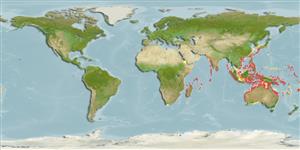Common names from other countries
Environment: milieu / climate zone / depth range / distribution range
Ecologia
Associadas(os) a recifes; intervalo de profundidade 0 - 44 m (Ref. 81548). Tropical
Southeast Atlantic and Indo-West Pacific: South Africa to Australia and Japan.
Length at first maturity / Tamanho / Peso / Idade
Maturity: Lm ? range ? - ? cm
Maximum length of arms: 3.0 cm. Associated with coral communities. Dwells in a variety of substrates. Feeds on encrusting turf over hard substrates (Ref. 129602). Occurs in healthy shallow reef areas at depths of 1 to 25 m.
Life cycle and mating behavior
Maturidade | Reprodução | Desova | Ovos | Fecundidade | Larvas
Members of the class Asteroidea exhibit both asexual (regeneration and clonal) and sexual (gonochoric) means of reproduction. Life cycle: Embryos hatch into planktonic larvae and later metamorphose into pentamorous juveniles which develop into young sea stars with stubby arms.
Schoppe, S. 2000. (Ref. 800)
Status na Lista Vermelha da IUCN (Ref. 130435)
Status no CITES (Ref. 108899)
Not Evaluated
Not Evaluated
Perigo para os humanos
Harmless
Uso pelos humanos
| FishSource |
Ferramentas
Mais informação
Idade/Tamanho
Crescimento
Comprimento-peso
Comprimento-comprimento
Morfologia
Larvas
Abundância
Fontes da internet
Estimates based on models
Preferred temperature
(Ref.
115969): 24.4 - 29, mean 27.8 (based on 836 cells).
Categoria de preço
Unknown.
